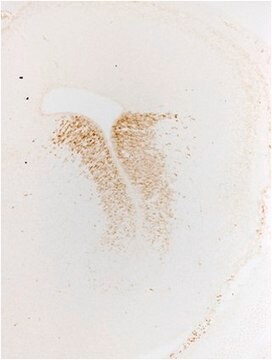AB1511
Anti-Glutamate Decarboxylase 65 & 67 Antibody
Chemicon®, from rabbit
Synonym(s):
65 kDa glutamic acid decarboxylase, Glutamate decarboxylase 65 kDa isoform, Glutamate decarboxylase-2 (pancreas), glutamate decarboxylase 2, glutamate decarboxylase 2 (pancreatic islets and brain,65kD), glutamate decarboxylase 2 (pancreatic islets and br
About This Item
Recommended Products
biological source
rabbit
antibody form
saturated ammonium sulfate (SAS) precipitated
antibody product type
primary antibodies
clone
polyclonal
species reactivity
mouse, feline, rat, human
manufacturer/tradename
Chemicon®
technique(s)
immunohistochemistry: suitable
western blot: suitable
NCBI accession no.
UniProt accession no.
shipped in
dry ice
target post-translational modification
unmodified
Gene Information
human ... GAD2(2572)
General description
Specificity
Western blot reveals a doublet at approximately 65/68 kDa.
Immunohistochemical staining can be abolished by preincubation with 1-10 μg peptide (Catalog Number AG252) per mL of diluted antibody.
Immunogen
Application
1:200-1:5,000 dilution of a previous lot was used in immunohistochemistry (overnight PAP or ABC). Several fixative solutions may be used. Aldehyde-combination fixatives (i.e. those containing formaldehyde and glutaraldehyde) usually give satisfactory results. Bouin and Susa fixatives containing 0.1-0.2% glutaraldehyde have been used satisfactorily. Also reactive on paraffin embedded tissue. Protease digestion is not required.
Optimal working dilutions must be determined by the end user.
Neuroscience
Neurotransmitters & Receptors
Neuronal & Glial Markers
Quality
Western Blot Analysis:
1:500 dilution of this antibody detected GAD 65&67 on 10 μg of mouse brain lysates.
Target description
Physical form
Storage and Stability
Handling Recommendations: Upon first thaw, and prior to removing the cap, centrifuge the vial and gently mix the solution. Aliquot into microcentrifuge tubes and store at -20°C. Avoid repeated freeze/thaw cycles, which may damage IgG and affect product performance.
Analysis Note
Whole rat brain lysate, mouse brain cell extract.
Other Notes
Legal Information
Disclaimer
Not finding the right product?
Try our Product Selector Tool.
recommended
Storage Class Code
12 - Non Combustible Liquids
WGK
WGK 1
Flash Point(F)
Not applicable
Flash Point(C)
Not applicable
Certificates of Analysis (COA)
Search for Certificates of Analysis (COA) by entering the products Lot/Batch Number. Lot and Batch Numbers can be found on a product’s label following the words ‘Lot’ or ‘Batch’.
Already Own This Product?
Find documentation for the products that you have recently purchased in the Document Library.
Our team of scientists has experience in all areas of research including Life Science, Material Science, Chemical Synthesis, Chromatography, Analytical and many others.
Contact Technical Service








